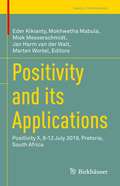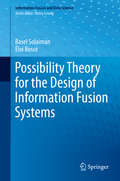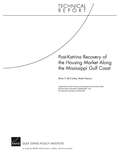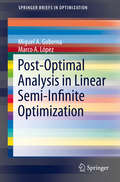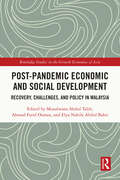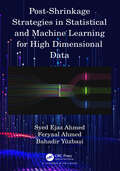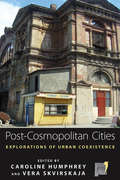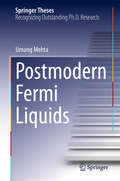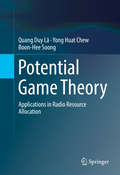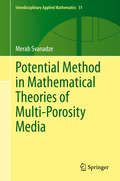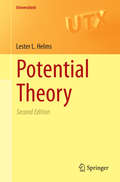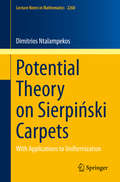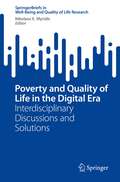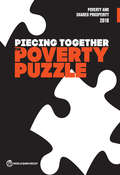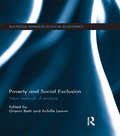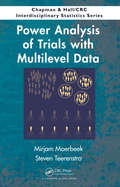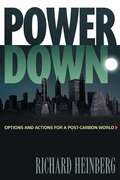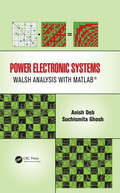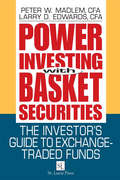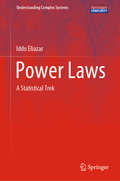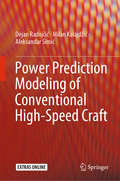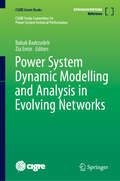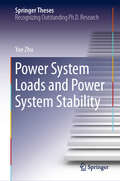- Table View
- List View
Positivity and its Applications: Positivity X, 8-12 July 2019, Pretoria, South Africa (Trends in Mathematics)
by Eder Kikianty Mokhwetha Mabula Miek Messerschmidt Jan Harm van der Walt Marten WortelThis proceedings volume features selected contributions from the conference Positivity X. The field of positivity deals with ordered mathematical structures and their applications. At the biannual series of Positivity conferences, the latest developments in this diverse field are presented. The 2019 edition was no different, with lectures covering a broad spectrum of topics, including vector and Banach lattices and operators on such spaces, abstract stochastic processes in an ordered setting, the theory and applications of positive semi-groups to partial differential equations, Hilbert geometries, positivity in Banach algebras and, in particular, operator algebras, as well as applications to mathematical economics and financial mathematics. The contributions in this book reflect the variety of topics discussed at the conference. They will be of interest to researchers in functional analysis, operator theory, measure and integration theory, operator algebras, and economics. Positivity X was dedicated to the memory of our late colleague and friend, Coenraad Labuschagne. His untimely death in 2018 came as an enormous shock to the Positivity community. He was a prominent figure in the Positivity community and was at the forefront of the recent development of abstract stochastic processes in a vector lattice context.
Positivity in Arakelov Geometry over Adelic Curves: Hilbert-Samuel Formula and Equidistribution Theorem (Progress in Mathematics #355)
by Huayi Chen Atsushi MoriwakiThis monograph presents new research on Arakelov geometry over adelic curves, a novel theory of arithmetic geometry developed by the authors. It explores positivity conditions and establishes the Hilbert-Samuel formula and the equidistribution theorem in the context of adelic curves. Connections with several classical topics in Arakelov geometry and Diophantine geometry are highlighted, such as the arithmetic Hilbert-Samuel formula, positivity of line bundles, equidistribution of small subvarieties, and theorems resembling the Bogomolov conjecture. Detailed proofs and explanations are provided to ensure the text is accessible to both graduate students and experienced researchers.
Possibility Theory for the Design of Information Fusion Systems (Information Fusion and Data Science)
by Éloi Bossé Basel SolaimanThis practical guidebook describes the basic concepts, the mathematical developments, and the engineering methodologies for exploiting possibility theory for the computer-based design of an information fusion system where the goal is decision support for industries in smart ICT (information and communications technologies). This exploitation of possibility theory improves upon probability theory, complements Dempster-Shafer theory, and fills an important gap in this era of Big Data and Internet of Things.The book discusses fundamental possibilistic concepts: distribution, necessity measure, possibility measure, joint distribution, conditioning, distances, similarity measures, possibilistic decisions, fuzzy sets, fuzzy measures and integrals, and finally, the interrelated theories of uncertainty..uncertainty. These topics form an essential tour of the mathematical tools needed for the latter chapters of the book. These chapters present applications related to decision-making and pattern recognition schemes, and finally, a concluding chapter on the use of possibility theory in the overall challenging design of an information fusion system. This book will appeal to researchers and professionals in the field of information fusion and analytics, information and knowledge processing, smart ICT, and decision support systems.
Post-Katrina Recovery of the Housing Market Along the Mississippi Gulf Coast
by Kevin F. Mccarthy Mark HansonIn summer 2006, the Commission on Recovery, Rebuilding, and Renewal asked the RAND Gulf States Policy Institute to describe the state of the pre-Hurricane Katrina housing markets in Mississippi's three coastal counties, to estimate the damage the storm did to their housing markets, to describe the status of the recovery effort, and to identify problems that might inhibit it. This report publishes the findings.
Post-Optimal Analysis in Linear Semi-Infinite Optimization
by Miguel A. Goberna Marco A. LópezPost-Optimal Analysis in Linear Semi-Infinite Optimization examines the following topics in regards to linear semi-infinite optimization: modeling uncertainty, qualitative stability analysis, quantitative stability analysis and sensitivity analysis. Linear semi-infinite optimization (LSIO) deals with linear optimization problems where the dimension of the decision space or the number of constraints is infinite. The authors compare the post-optimal analysis with alternative approaches to uncertain LSIO problems and provide readers with criteria to choose the best way to model a given uncertain LSIO problem depending on the nature and quality of the data along with the available software. This work also contains open problems which readers will find intriguing a challenging. Post-Optimal Analysis in Linear Semi-Infinite Optimization is aimed toward researchers, graduate and post-graduate students of mathematics interested in optimization, parametric optimization and related topics.
Post-Pandemic Economic and Social Development: Recovery, Challenges, and Policy in Malaysia (Routledge Studies in the Growth Economies of Asia)
by Muzalwana Abdul Talib Ahmad Farid Osman Bahri, Elya Nabila AbdulThis book explores Malaysia’s experience during the COVID-19 pandemic, analyzing the profound economic and societal challenges faced from 2020 to 2022.The coverage of Malaysia’s post-pandemic recovery provides valuable insights into ongoing global issues. Contributors to this book address a wide range of topics, including unemployment, monetary and trade policies, tourism, human capital development, and women’s labor participation. They also examine the rise of the gig economy, poverty alleviation efforts, and social safety nets. By presenting model applications and empirical research, the book offers data-driven policy advice to handle challenges that arise from pandemics, such as rising inflation, supply chain disruptions, disparities and sustainability issues.This book will interest academics and researchers in the field of econometrics, Asian economics and Malaysian studies. It will also act as a useful guide for NGOs, practitioners, public administrators, and economic policymakers involved in post-COVID-19 economic revival and policy development.
Post-Shrinkage Strategies in Statistical and Machine Learning for High Dimensional Data
by Syed Ejaz Ahmed Feryaal Ahmed Bahadir YüzbaşıThis book presents some post-estimation and predictions strategies for the host of useful statistical models with applications in data science. It combines statistical learning and machine learning techniques in a unique and optimal way. It is well-known that machine learning methods are subject to many issues relating to bias, and consequently the mean squared error and prediction error may explode. For this reason, we suggest shrinkage strategies to control the bias by combining a submodel selected by a penalized method with a model with many features. Further, the suggested shrinkage methodology can be successfully implemented for high dimensional data analysis. Many researchers in statistics and medical sciences work with big data. They need to analyse this data through statistical modelling. Estimating the model parameters accurately is an important part of the data analysis. This book may be a repository for developing improve estimation strategies for statisticians. This book will help researchers and practitioners for their teaching and advanced research, and is an excellent textbook for advanced undergraduate and graduate courses involving shrinkage, statistical, and machine learning. The book succinctly reveals the bias inherited in machine learning method and successfully provides tools, tricks and tips to deal with the bias issue. Expertly sheds light on the fundamental reasoning for model selection and post estimation using shrinkage and related strategies. This presentation is fundamental, because shrinkage and other methods appropriate for model selection and estimation problems and there is a growing interest in this area to fill the gap between competitive strategies. Application of these strategies to real life data set from many walks of life. Analytical results are fully corroborated by numerical work and numerous worked examples are included in each chapter with numerous graphs for data visualization. The presentation and style of the book clearly makes it accessible to a broad audience. It offers rich, concise expositions of each strategy and clearly describes how to use each estimation strategy for the problem at hand. This book emphasizes that statistics/statisticians can play a dominant role in solving Big Data problems, and will put them on the precipice of scientific discovery. The book contributes novel methodologies for HDDA and will open a door for continued research in this hot area. The practical impact of the proposed work stems from wide applications. The developed computational packages will aid in analyzing a broad range of applications in many walks of life.
Post-cosmopolitan Cities
by Caroline Humphrey Vera SkvirskajaExamining the way people imagine and interact in their cities, this book explores the post-cosmopolitan city. The contributors consider the effects of migration, national, and religious revivals (with their new aesthetic sensibilities), the dispositions of marginalized economic actors, and globalized tourism on urban sociality. The case studies here share the situation of having been incorporated in previous political regimes (imperial, colonial, socialist) that one way or another created their own kind of cosmopolitanism, and now these cities are experiencing the aftermath of these regimes while being exposed to new national politics and migratory flows of people.
Postmodern Fermi Liquids (Springer Theses)
by Umang MehtaThis thesis develops a new approach to Fermi liquids based on the mathematical formalism of coadjoint orbits, allowing Landau’s Fermi liquid theory to be recast in a simple and elegant way as a field theory. The theory of Fermi liquids is a cornerstone of condensed matter physics with many applications, but efforts to cast Landau’s Fermi liquid theory in the modern language of effective field theory suffer from technical and conceptual difficulties: the Fermi surface seems to defy a simple effective field theory description. This thesis reviews the recently-developed formalism for Fermi liquids that exploits an underlying structure described by the group of canonical transformations of a single particle phase space. This infinite-dimensional group governs the space of states of zero temperature Fermi liquids and allows one to write down a nonlinear, bosonized action that reproduces Landau’s kinetic theory in the classical limit. The thesis then describes how that Fermi liquid theory can essentially be thought of as a non-trivial representation of the Lie group of canonical transformations, bringing it within the fold of effective theories in many-body physics whose structure is determined by symmetries. After analyzing the benefits and limitations of this geometric formalism, pathways to extensions of the formalism to include superconducting and magnetic phases, as well as applications to the problem of non-Fermi liquids, are discussed. The thesis begins with a pedagogical review of Fermi liquid theory and concludes with a discussion on possible future directions for Fermi surface physics, and more broadly, the usefulness of diffeomorphism groups in condensed matter physics.
Potential Game Theory
by Quang Duy Lã Yong Huat Chew Boon-Hee SoongThis book offers a thorough examination of potential game theory and its applications in radio resource management for wireless communications systems and networking. The book addresses two major research goals: how to identify a given game as a potential game, and how to design the utility functions and the potential functions with certain special properties in order to formulate a potential game. After proposing a unifying mathematical framework for the identification of potential games, the text surveys existing applications of this technique within wireless communications and networking problems found in OFDMA 3G/4G/WiFi networks, as well as next-generation systems such as cognitive radios and dynamic spectrum access networks. Professionals interested in understanding the theoretical aspect of this specialized field will find Potential Game Theory a valuable resource, as will advanced-level engineering students. It paves the way for extensive and rigorous research exploration on a topic whose capacity for practical applications is vast but not yet fully exploited.
Potential Method in Mathematical Theories of Multi-Porosity Media (Interdisciplinary Applied Mathematics #51)
by Merab SvanadzeThis monograph explores the application of the potential method to three-dimensional problems of the mathematical theories of elasticity and thermoelasticity for multi-porosity materials. These models offer several new possibilities for the study of important problems in engineering and mechanics involving multi-porosity materials, including geological materials (e.g., oil, gas, and geothermal reservoirs); manufactured porous materials (e.g., ceramics and pressed powders); and biomaterials (e.g., bone and the human brain). Proceeding from basic to more advanced material, the first part of the book begins with fundamental solutions in elasticity, followed by Galerkin-type solutions and Green’s formulae in elasticity and problems of steady vibrations, quasi-static, and pseudo-oscillations for multi-porosity materials. The next part follows a similar format for thermoelasticity, concluding with a chapter on problems of heat conduction for rigid bodies. The final chapter then presents a number of open research problems to which the results presented here can be applied. All results discussed by the author have not been published previously and offer new insights into these models.Potential Method in Mathematical Theories of Multi-Porosity Media will be a valuable resource for applied mathematicians, mechanical, civil, and aerospace engineers, and researchers studying continuum mechanics. Readers should be knowledgeable in classical theories of elasticity and thermoelasticity.
Potential Theory
by Lester L. HelmsPotential Theory presents a clear path from calculus to classical potential theory and beyond, with the aim of moving the reader into the area of mathematical research as quickly as possible. The subject matter is developed from first principles using only calculus. Commencing with the inverse square law for gravitational and electromagnetic forces and the divergence theorem, the author develops methods for constructing solutions of Laplace's equation on a region with prescribed values on the boundary of the region. The latter half of the book addresses more advanced material aimed at those with the background of a senior undergraduate or beginning graduate course in real analysis. Starting with solutions of the Dirichlet problem subject to mixed boundary conditions on the simplest of regions, methods of morphing such solutions onto solutions of Poisson's equation on more general regions are developed using diffeomorphisms and the Perron-Wiener-Brelot method, culminating in application to Brownian motion. In this new edition, many exercises have been added to reconnect the subject matter to the physical sciences. This book will undoubtedly be useful to graduate students and researchers in mathematics, physics and engineering.
Potential Theory on Sierpiński Carpets: With Applications to Uniformization (Lecture Notes in Mathematics #2268)
by Dimitrios NtalampekosThis self-contained book lays the foundations for a systematic understanding of potential theoretic and uniformization problems on fractal Sierpiński carpets, and proposes a theory based on the latest developments in the field of analysis on metric spaces. The first part focuses on the development of an innovative theory of harmonic functions that is suitable for Sierpiński carpets but differs from the classical approach of potential theory in metric spaces. The second part describes how this theory is utilized to prove a uniformization result for Sierpiński carpets. This book is intended for researchers in the fields of potential theory, quasiconformal geometry, geometric group theory, complex dynamics, geometric function theory and PDEs.
Poverty and Quality of Life in the Digital Era: Interdisciplinary Discussions and Solutions (SpringerBriefs in Well-Being and Quality of Life Research)
by Nikolaos E. MyridisThis book proposes new solutions to the problem of poverty, and begins with providing analyses. It bases most of the analyses and solutions in the context of the digital era. The book also follows, in addition to a scientific distribution, a spatial-geographical one: analyses of countries of the European Union as well as South Africa, while it referring to two main variables, television and art, as agents of poverty alleviation. The book places particular focus on how poverty is understood in the framework of Industry 4.0. It introduces a new expanded Multidimensional Poverty Index with more than 20 dimensions; moreover, it provides a mathematically based solution for the disposal of perishable food. Finally, it does not disregard the crucial aspect of the issue of poverty: that of education planning. This book is of interest to specialists in poverty research, from students to professionals and from professors to activists, without excluding engineers.
Poverty and Shared Prosperity 2018: Piecing Together the Poverty Puzzle (Poverty and Shared Prosperity)
by World BankThe World Bank Group has two overarching goals: End extreme poverty by 2030 and promote shared prosperity by boosting the incomes of the bottom 40 percent of the population in each economy. As this year’s Poverty and Shared Prosperity report documents, the world continues to make progress toward these goals. In 2015, approximately one-tenth of the world’s population lived in extreme poverty, and the incomes of the bottom 40 percent rose in 77 percent of economies studied. But success cannot be taken for granted. Poverty remains high in Sub- Saharan Africa, as well as in fragile and conflict-affected states. At the same time, most of the world’s poor now live in middle-income countries, which tend to have higher national poverty lines. This year’s report tracks poverty comparisons at two higher poverty thresholds—$3.20 and $5.50 per day—which are typical of standards in lower- and upper-middle-income countries. In addition, the report introduces a societal poverty line based on each economy’s median income or consumption. Poverty and Shared Prosperity 2018: Piecing Together the Poverty Puzzle also recognizes that poverty is not only about income and consumption—and it introduces a multidimensional poverty measure that adds other factors, such as access to education, electricity, drinking water, and sanitation. It also explores how inequality within households could affect the global profile of the poor. All these additional pieces enrich our understanding of the poverty puzzle, bringing us closer to solving it. For more information, please visit worldbank.org/PSP
Poverty and Social Exclusion: New Methods of Analysis (Routledge Advances in Social Economics #3)
by Gianni Betti Achille LemmiPoverty and inequality remain at the top of the global economic agenda, and the methodology of measuring poverty continues to be a key area of research. This new book, from a leading international group of scholars, offers an up to date and innovative survey of new methods for estimating poverty at the local level, as well as the most recent multidimensional methods of the dynamics of poverty. It is argued here that measures of poverty and inequality are most useful to policy-makers and researchers when they are finely disaggregated into small geographic units. Poverty and Social Exclusion: New Methods of Analysis is the first attempt to compile the most recent research results on local estimates of multidimensional deprivation. The methods offered here take both traditional and multidimensional approaches, with a focus on using the methodology for the construction of time-related measures of deprivation at the individual and aggregated levels. In analysis of persistence over time, the book also explores whether the level of deprivation is defined in terms of relative inequality in society, or in relation to some supposedly absolute standard. This book is of particular importance as the continuing international economic and financial crisis has led to the impoverishment of segments of population as a result of unemployment, bankruptcy, and difficulties in obtaining credit. The volume will therefore be of interest to all those working on economic, econometric and statistical methods and empirical analyses in the areas of poverty, social exclusion and income inequality.
Power Analysis of Trials with Multilevel Data (Chapman & Hall/CRC Interdisciplinary Statistics)
by Mirjam Moerbeek Steven TeerenstraPower Analysis of Trials with Multilevel Data is a valuable reference for anyone who wants to perform power calculations on trials with hierarchical data. It provides a thorough overview of power analysis, familiarizing you with terminology and notation, outlining the key concepts of statistical power and power analysis, and covering all common hierarchical designs.
Power Down: Options and Actions for a Post-Carbon World
by Richard HeinbergIf the US continues with its current policies, the next decades will be marked by war, economic collapse, and environmental catastrophe. Resource depletion and population pressures are about to catch up with us, and no one is prepared. The political elites, especially in the US, are incapable of dealing with the situation and have in mind a punishing game of "Last One Standing." The alternative is "Powerdown," a strategy that will require tremendous effort and economic sacrifice in order to reduce per-capita resource usage in wealthy countries, develop alternative energy sources, distribute resources more equitably, and reduce the human population humanely but systematically over time. While civil society organizations push for a mild version of this, the vast majority of the world's people are in the dark, not understanding the challenges ahead, nor the options realistically available. Powerdown speaks frankly to these dilemmas. Avoiding cynicism and despair, it begins with an overview of the likely impacts of oil and natural gas depletion and then outlines four options for industrial societies during the next decades: Last One Standing: the path of competition for remaining resources; Powerdown: the path of cooperation, conservation and sharing; Waiting for a Magic Elixir: wishful thinking, false hopes, and denial; Building Lifeboats: the path of community solidarity and preservation. Finally, the book explores how three important groups within global society-the power elites, the opposition to the elites (the antiwar and antiglobalization movements, et al: the "Other Superpower"), and ordinary people-are likely to respond to these four options. Timely, accessible and eloquent, Powerdown is crucial reading for our times. Richard Heinberg is an award-winning author of five previous books, including The Party's Over: Oil, War and the Fate of Industrial Societies.
Power Electronic Systems: Walsh Analysis with MATLAB®
by Anish Deb Suchismita GhoshA Totally Different Outlook on Power Electronic System Analysis Power Electronic Systems: Walsh Analysis with MATLAB® builds a case for Walsh analysis as a powerful tool in the study of power electronic systems. It considers the application of Walsh functions in analyzing power electronic systems, and the advantages offered by Walsh domain analysis of power electronic systems. Solves Power Electronic Systems in an Unconventional Way This book successfully integrates power electronics as well as systems and control. Incorporating a complete orthonormal function set very much unlike the sine–cosine functions, it introduces a blending between piecewise constant orthogonal functions and power electronic systems. It explores the background and evolution of power electronics, and discusses Walsh and related orthogonal basis functions. It develops the mathematical foundation of Walsh analysis, and first- and second-order system analyses by Walsh technique. It also describes the Walsh domain operational method and how it is applied to linear system analysis. Introduces Theories Step by Step While presenting the underlying principles of Walsh analysis, the authors incorporate many illustrative examples, and include a basic introduction to linear algebra and MATLAB® programs. They also examine different orthogonal piecewise constant basis functions like Haar, Walsh, slant, block pulse functions, and other related orthogonal functions along with their time scale evolution. • Analyzes pulse–fed single input single output (SISO) first- and second-order systems • Considers stepwise and continuously pulse width modulated chopper systems • Describes a detailed analysis of controlled rectifier circuits • Addresses inverter circuits Power Electronic Systems: Walsh Analysis with MATLAB® is written for postgraduate students, researchers, and academicians in the area of power electronics as well as systems and control.
Power Investing With Basket Securities: The Investor's Guide to Exchange-Traded Funds
by Peter W. Madlem Larry D. EdwardsTremendously versatile, basket securities have the potential to change the way money is managed. This book provides the proper definition of the basket security, a brief exploration of their true history, and powerful ways to exploit their advantages. The authors explore simple yet effective ways basket securities can be used in asset management strategies including trading the market, building a diversified core, or creating a thousand stock portfolio. They cover the broad array of currently available basket securities and discuss others that are on the horizon, what and when to buy and sell, and how to protect investments from market declines.
Power Laws: A Statistical Trek (Understanding Complex Systems)
by Iddo EliazarThis monograph is a comprehensive and cohesive exposition of power-law statistics. Following a bottom-up construction from a foundational bedrock – the power Poisson process – this monograph presents a unified study of an assortment of power-law statistics including: Pareto laws, Zipf laws, Weibull and Fréchet laws, power Lorenz curves, Lévy laws, power Newcomb-Benford laws, sub-diffusion and super-diffusion, and 1/f and flicker noises. The bedrock power Poisson process, as well as the assortment of power-law statistics, are investigated via diverse perspectives: structural, stochastic, fractal, dynamical, and socioeconomic. This monograph is poised to serve researchers and practitioners – from various fields of science and engineering – that are engaged in analyses of power-law statistics.
Power Prediction Modeling of Conventional High-Speed Craft
by Dejan Radojčić Milan Kalajdžić Aleksandar SimićThe proposed book addresses various power prediction methods, a principal design objective for high-speed craft of displacement, semi-displacement, and planing type. At the core of the power prediction methods are mathematical models based on experimental data derived from various high-speed hull and propeller series. Regression analysis and Artificial Neural Network (ANN) methods are used as extraction tools for this kind of models.The most significant factors for in-service power prediction are bare hull resistance, dynamic trim, and the propeller’s open-water efficiency. Therefore, mathematical modeling of these factors is a specific focus of the book. Furthermore, the book includes a summary of most of the power-prediction-relevant literature published in the last 50 years, and as such is intended as a reference overview of the best high-speed craft modeling practices.Once these mathematical models have been developed and validated, they can be readily programmed into software tools, thereby enabling the parametric analyses required for the optimization of a high-speed craft design. The proposed book is intended primarily for naval architects who design and develop various types of high-speed vessels (yachts, boats etc.), as well as for students who are interested in the design of fast vessels. The book includes useful Excel Macro Codes for the outlined mathematical models. Moreover, software for all considered models is provided.
Power System Dynamic Modelling and Analysis in Evolving Networks (CIGRE Green Books)
by Babak Badrzadeh Zia EminThis Green Book is an essential resource for power system engineers seeking comprehensive information on contemporary power system dynamic modelling and analysis. With today's rapid adoption of inverter-based resources and the resulting changes in power system dynamics, this book compares conventional power systems with evolving power systems characterized by high shares of grid-connected and distributed inverter-based resources. It covers dynamic phenomena, analysis methods, simulation tools and enablers required for secure and reliable system planning and operation. Starting with an overview of power system studies and associated analysis tools, the book provides modelling requirements for various power system components, including existing and emerging technologies. It includes practical examples from real-world power systems worldwide that act as step-by-step study guides for practising engineers and provides knowledge to apply in their day-to-day tasks. Additionally, the book emphasizes the importance of power system model acceptance testing and validation, providing practical examples of various testing methods. Written with practising power system engineers in mind, this book minimizes the use of advanced mathematics. However, relevant sources for those interested in learning more about mathematical concepts are provided. Overall, this book is an invaluable resource for power system engineers navigating contemporary power systems. Readers who would like to comment on any of the published books or identify errors to the editorial team please contact: cigregreenbooks@springer.com.
Power System Loads and Power System Stability (Springer Theses)
by Yue ZhuThis thesis develops a pioneering methodology and a concept for identifying critical loads and load model parameters in large power networks based on their influence on power system stability. The research described in the thesis first develops an automatic load modelling tool (ALMT) that can be used to automatically build load model from actual measured power system data without human intervention and the benefits of the ALMY are explored. Secondly, it develops a pioneering framework based on Morris screening method for ranking power system load model parameters based on their influence on overall power system stability (voltage, frequency, transient and small disturbance stability) considering different load models and loading conditions. Thirdly, a novel probabilistic methodology for determining the accuracy levels of critical load model parameters has been developed. This book will be of interest to students and researchers within the field of electrical engineering, as well as industry professionals.
Power Up Workbook: Course 3 (Saxon Math)
by Stephen HakeThe Power Up section of each lesson in Saxon Math Course 3 is designed to build your mathematical power. Each Power Up has three parts: Facts Practice, Mental Math, and Problem Solving. <p><p> The three parts are printed on every Power Up page where you will record your answers. This workbook contains a Power Up page for every lesson.
